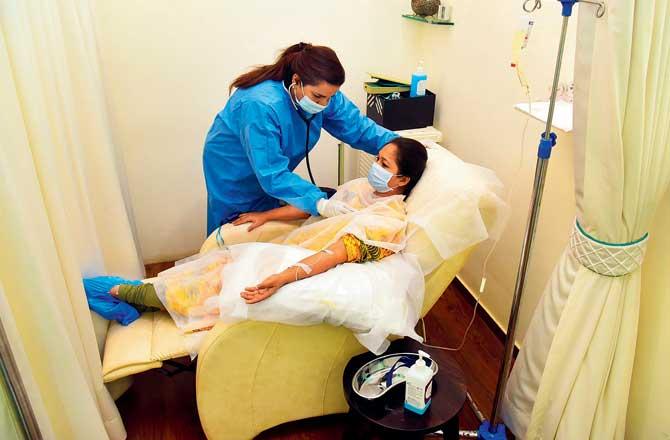A patient receives IV nutrient therapy at Dr Rashmi Rai’s clinic in Khar. The hydrating drip typically contains a blend of minerals, antioxidants and amino acids. Pics/Shadab Khan While working as an intregrative lifestyle medicine specialist in Bangkok, Dr Rashmi Rai would routinely see patients walk in for intravenous (IV) shots for glowing skin or quick recovery from dehydration, allergies, and at times even hangovers. Later when she moved to Europe, she was exposed to a more advanced form of IV nutrient therapy. "There were dedicated drip lounges that offered services that became part of people’s wellness routine," she says. After returning to Mumbai, she introduced the treatment at her Khar clinic. A rage in the west, intravenous infusions have emerged as a way to improve health from the inside out, after being endorsed by celebrities like Rihanna, Kim Kardashian, Chris Brown, Jane Fonda and Simon Cowell.
Since the Coronavirus outbreak, IV nutrient therapy is gaining favour as a quick and painless way to improve immunity. The hydrating drip typically contains a blend of IV fluids, vitamins, minerals, antioxidants and amino acids. Rai says the number of patients seeking IV nutrient therapy has doubled. The concept is not new, though. The first IV vitamin drips were developed and administered by a physician in Baltimore named Dr John Myers in the 1970s. His research led to the popular Myers’ Cocktail, which works on the principle of increasing the blood concentration of several essential vitamins and minerals through IV infusion.
Rai says the idea is also associated with digestive disturbances such as bloating, indigestion; these conditions may hinder the absorption of nutrients needed to return them to good health.
Dr Rashmi Rai, Dr Tushar Rane and Dr Amit Gawande
"A vitamin that’s taken orally gets broken down in the stomach and digestive tract, and is limited to how much can be absorbed. But when the vitamin is given through an IV, it’s absorbed at a much higher percentage as it directly hits the bloodstream," explains Rai. At her clinic, the process begins with a consultation, followed by a blood test and then another consultation before the actual session unfolds. If a complication crops up, they don’t go ahead. People with allergies and heart conditions or kidney disease are advised to abstain from IV vitamin therapy because they cannot quickly remove certain minerals from the body.
The 45-minute to an hour-long procedure is […]
